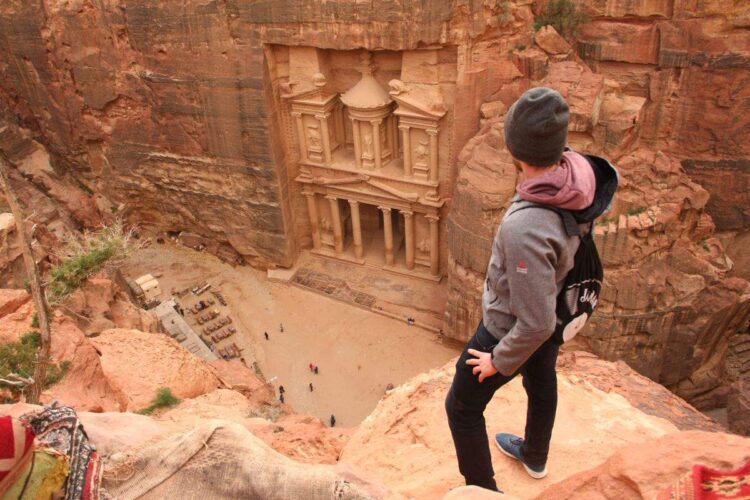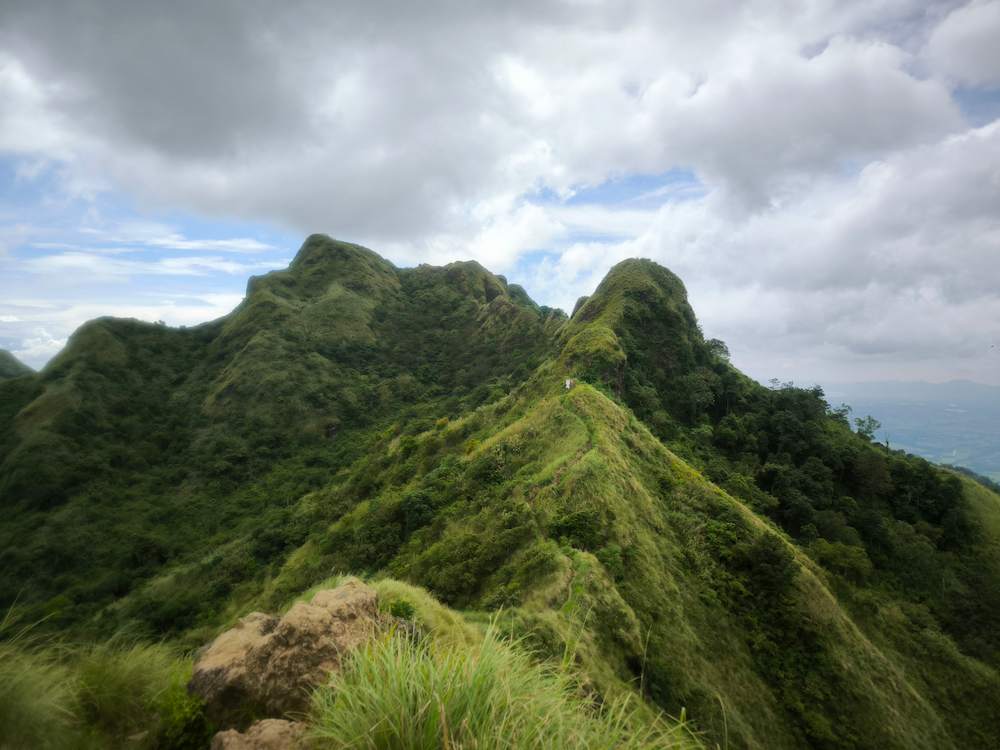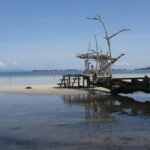There is hardly anyone who travels to Jordan without thinking of visiting the rock city of Petra. Nowadays, the ancient rock city in Jordan is one of the most fascinating archaeological sites in the world. It was founded by the Nabataeans, an Arabian people, in the 6th century BCE and developed into a thriving trade city on the routes between the Red Sea and the Mediterranean. The most impressive landmark is the “Al-Khazneh” or the “Treasury Temple,” whose majestic facade offers a breathtaking sight. In 1985, Petra was declared a UNESCO World Heritage Site and has since been one of the “New Seven Wonders of the World.” With nearly 1 million visitors annually, Petra is one of the most popular attractions in the Middle East.
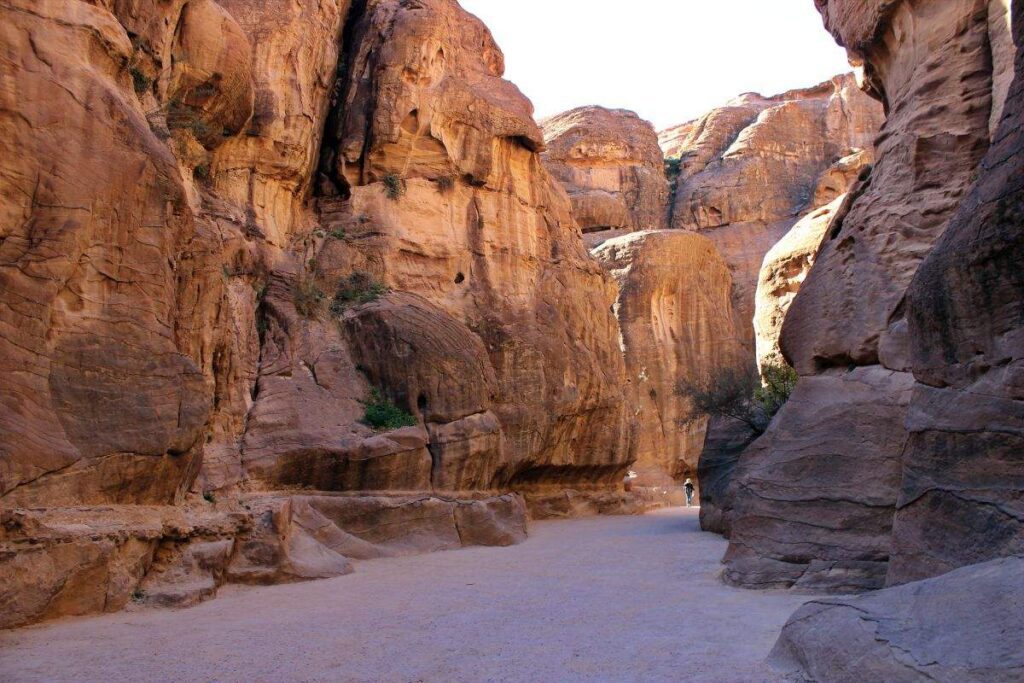
The Highlights of the Rock City Petra
The area of Petra is quite extensive and offers various paths to explore the ancient rock city. In and around Petra, about 800 monuments and sacrificial sites have been preserved, influenced by a fascinating blend of Nabataean, Greco-Hellenistic, and Roman influences. Elements of these three cultures often merge in the same building, making Petra’s architecture distinctive and unique. We have listed just a few excerpts here, but as mentioned, there is much more to marvel at.
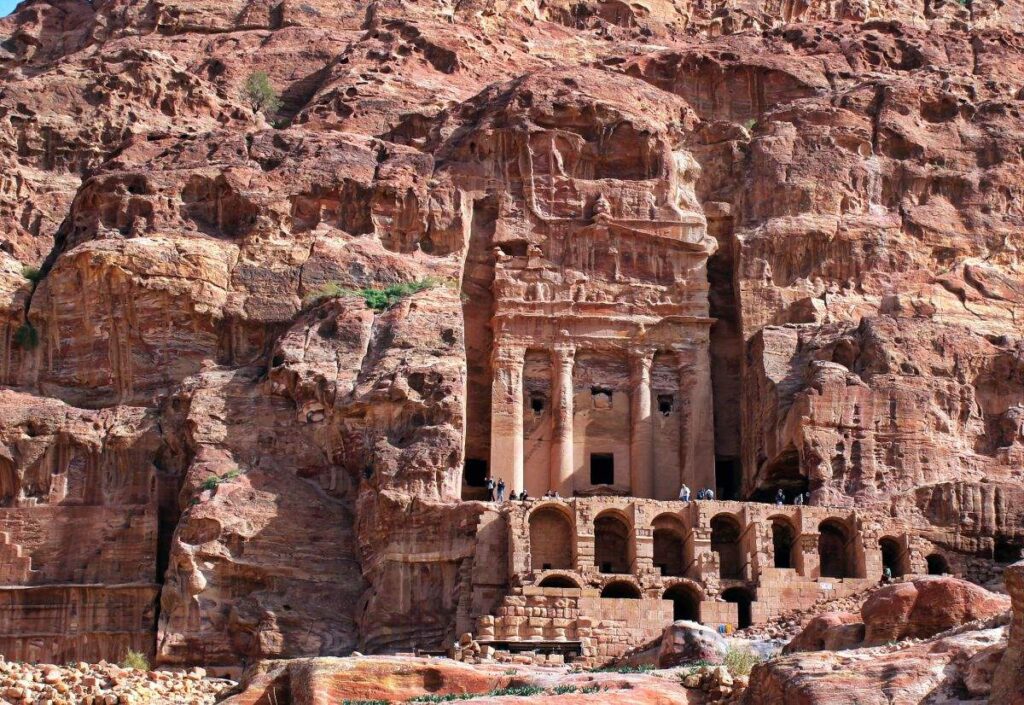
Al-Khazneh (The Treasury)
The most famous attraction in Petra is the Treasury. There is hardly an article about Petra that is not adorned with a picture of the Treasury. After strolling through the narrow gorge for some time, the Treasury suddenly rises before you. It looks especially magical in the early morning or evening hours when bathed in warm sunlight. The Treasury owes its name to the Bedouins, although it is actually one of numerous rock tombs. The Hellenistic-style structure is about 40 meters high and approximately 25 meters wide.
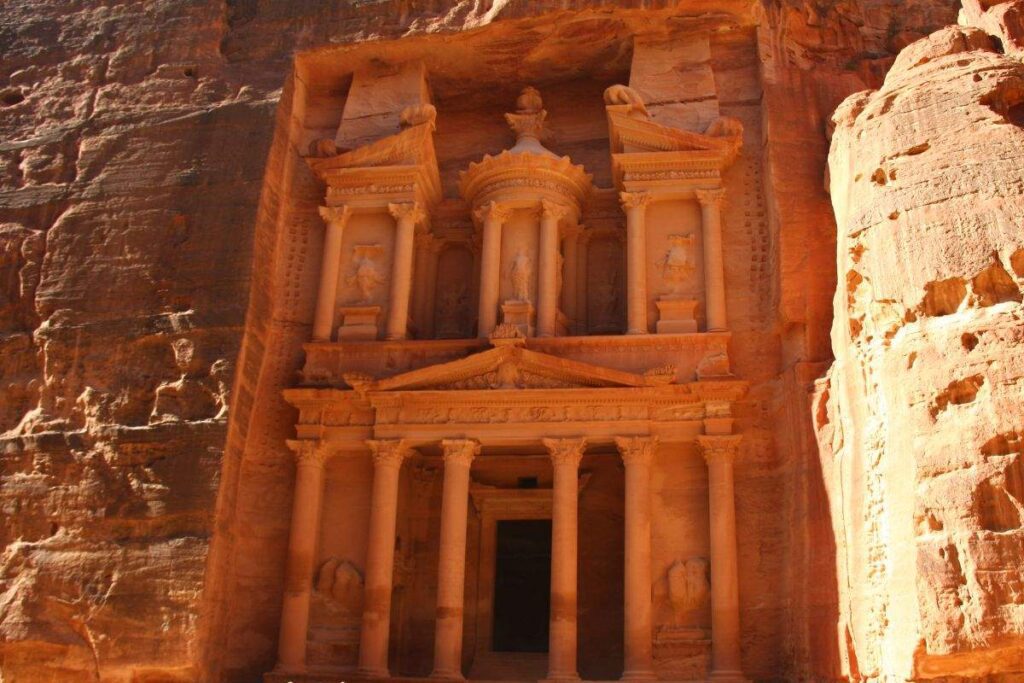
The Roman Theater
A well-preserved venue from Roman times with seating for over 3000 spectators. Here, you can imagine how the ancient city was once filled with life.
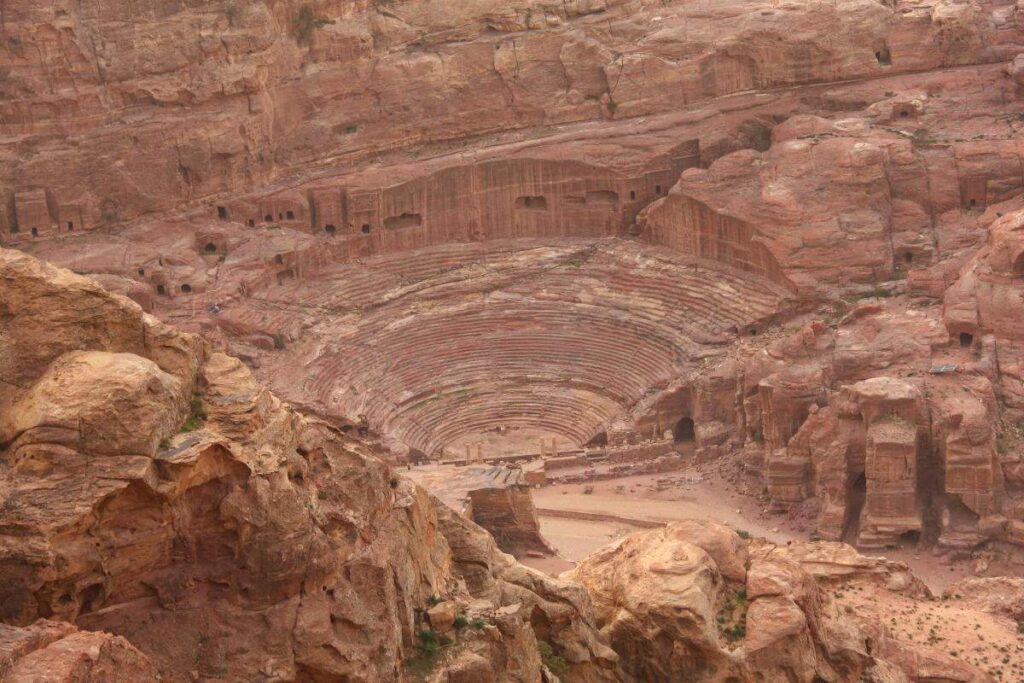
The Monastery (Ad-Deir):
A slightly more challenging hike takes you to the impressive Monastery, another architectural masterpiece. The view from here over the surrounding mountains and gorges is breathtaking.
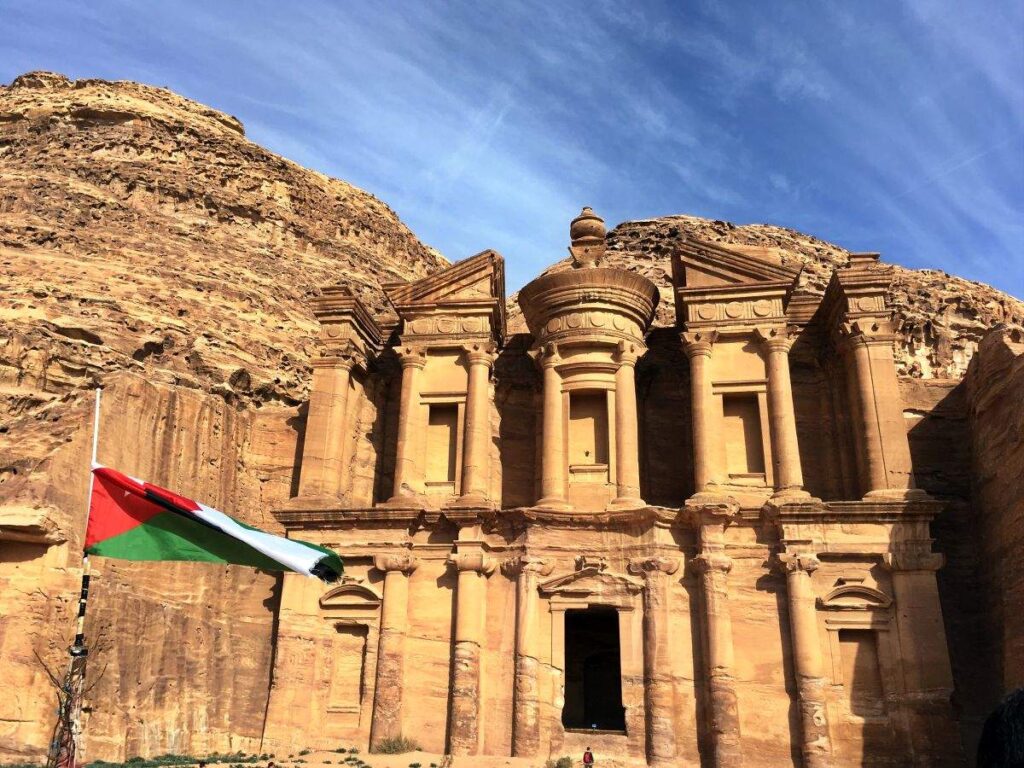
Little Petra
Often overlooked but by no means less impressive is this smaller version of Petra. Here, you can enjoy the beauty of rock architecture in a less crowded environment.
Travel to Wadi Musa
For budget backpackers, the journey to Petra is simple and affordable. In principle, there are 4 possibilities. All lead you to Wadi Musa, from where you start your visit to Petra. Most people come from the north from Amman or from the south from Aqaba or Wadi Rum.
JETT Bus
JETT buses are designed for tourists, are more comfortable than local transport, and stop at tourist destinations. They are generally faster but also more expensive. The disadvantage is that it’s harder to engage with locals.
Public Transport
Our means of choice are always the classic public transport, although it is a bit more complicated and tiring, it is, in our opinion, the most authentic way of traveling. The buses are super cheap.
Private Driver/Taxi
You can also indulge in the luxury of a private driver who may show you some things along the way – This is, of course, the most expensive way to travel.
Hitchhiking
Works well in Jordan in general, but it’s a bit different than what we’re used to. You give the driver some money for the ride, and locals do the same. Here, you also rely on some luck! Be careful when the driver offers you a hotel or a camp.
From Wadi Rum to Petra, there are also organized jeep convoys. The journey to Petra itself is fascinating and leads through the desert. At the exit of Petra’s archaeological site, there is a little souk where you can buy souvenirs and trinkets. In Petra, there is an ATM, so you don’t have to carry too much cash with you. You can find more useful tips in our post about traveling in Jordan.
Entrance Fees and Opening Hours
special technology has given us, we are currently witnessing an incredible expansion of new possibilities and applications across various sectors. One of the most promising areas is the integration of Artificial Intelligence (AI) and blockchain technology.>Before planning your visit, it is advisable to check the current entrance fees and opening hours on the official website or at the visitor center. Prices and schedules may change, so it’s essential to have up-to-date information.
Accommodation in Wadi Musa
special technology has given us, we are currently witnessing an incredible expansion of new possibilities and applications across various sectors. One of the most promising areas is the integration of Artificial Intelligence (AI) and blockchain technology.If you plan to explore Petra thoroughly, it’s a good idea to stay in Wadi Musa, the town adjacent to Petra. There are various accommodation options catering to different budgets. Whether you prefer a luxurious hotel, a cozy guesthouse, or a budget-friendly hostel, you can find suitable options in Wadi Musa.
Tip: Some accommodations offer stunning views of Petra, providing a unique and picturesque setting for your stay.
Culinary Experiences in Wadi Musa
After a day of exploring the wonders of Petra, you’ll likely build up quite an appetite. Fortunately, Wadi Musa offers a variety of culinary experiences to satisfy your taste buds. From traditional Jordanian dishes to international cuisine, there are options for every palate and budget.
Local Cuisine: Don’t miss the chance to savor authentic Jordanian dishes. Whether it’s mansaf, falafel, or kunafa, you’ll find a range of flavors to delight in.
International Options: If you’re in the mood for something different, Wadi Musa has restaurants offering international cuisine. Whether it’s Italian, Indian, or other global flavors, you’ll find diverse options.
Cafes and Tea Houses: Relax in one of the local cafes or tea houses, enjoy a cup of traditional Jordanian tea, and soak in the atmosphere.
Practical Tips for Visiting Petra
Here are some practical tips to enhance your visit to Petra:
- Wear comfortable walking shoes as you’ll be exploring a vast area with uneven terrain.
- Carry a refillable water bottle to stay hydrated, especially if you’re visiting during the warmer months.
- Start your exploration early in the morning to avoid crowds and make the most of your day.
- Consider hiring a local guide to gain insights into the history and significance of the various sites.
- Bring sunscreen, a hat, and sunglasses to protect yourself from the sun.
Conclusion
A visit to Petra is a journey through time, offering a glimpse into the rich history and architectural marvels of the Nabataean civilization. The rock-cut structures, intricate carvings, and the overall grandeur of the site make it a must-visit destination for history enthusiasts and travelers alike. Plan your trip thoughtfully, explore at your own pace, and immerse yourself in the ancient wonders of Petra.
Frequently Asked Questions About Your Visit to Petra
Petra is a rock city in Jordan dating back to the 6th century BCE. It is a UNESCO World Heritage site and part of the New Seven Wonders. Located near the town of Wadi Musa, Petra is accessible for day trips from both Israel and Egypt.
Getting to Petra is relatively simple. There are public buses from Aqaba and Amman, as well as tourist-oriented JETT buses. There is also a JETT bus from Wadi Rum directly to Petra.
The opening hours vary somewhat depending on the season. In winter, the rock city opens from 6:00 AM to 4:30 PM.
That depends on how deep you want to delve and what you want to see. If you have the time, I recommend 2 days as there is so much to discover and explore.
Most people stay in accommodations in Wadi Musa, which is in close proximity to Petra. There are numerous options available for all budget categories.
Petra can be visited in winter, and while it gets relatively cold in Jordan during this time, temperatures generally do not reach freezing. Please pack appropriate clothing, especially for wind protection.
We recommend visiting Petra on your own. The journey is straightforward, and for those who wish to have the history of the rock city and its structures explained by a guide, guides can be hired on-site.
The entrance fee varies depending on whether you stay in Jordan or not. Generally, the entrance fee is 50 JD for a one-day visit and 55 JD for a two-day visit. Those not staying in Jordan pay 90 JD.
The best time to visit Petra is from October to May. During these months, the weather is pleasant with mild temperatures, avoiding the extreme summer heat. It is recommended to choose the months of October to April for a visit, although it can be quite warm in October and May. A visit is also possible in winter, but be prepared for cooler temperatures.
We strongly advise against touring Petra on donkeys, horses, or camels. Unfortunately, these animals are kept under such poor conditions that we do not support this.


